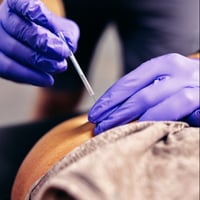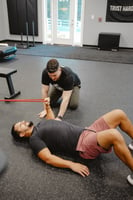In the world of modern Physical Therapy, recovery and performance care goes far beyond exercise....
Top 5 Questions Wilmington Patients Ask About Pain Relief with PT
If you’re dealing with pain, chances are you’ve considered physical therapy—but like many Wilmington patients, you probably have questions before you commit. Will it hurt? How long until it works? What actually happens during a session?
At Conquer Movement PT, we hear these questions every day—and they’re important. Understanding how physical therapy works (and what makes it effective) can help you make confident decisions about your care.
In this blog, we’re answering the top five most common questions we get from patients just like you—so you can feel informed, prepared, and one step closer to lasting relief.
READ: Is Cupping Right for You? What Wilmington Patients Need to Know
 1. How Does Physical Therapy Actually Relieve Pain?
1. How Does Physical Therapy Actually Relieve Pain?
One of the most common questions we hear at Conquer Movement PT is: “How does physical therapy actually help with pain?” The answer is rooted in how movement, touch, and body awareness work together to calm the nervous system and correct underlying dysfunction.
Pain often stems from more than just one injured area. It can be the result of joint stiffness, muscle imbalance, poor movement patterns, or chronic inflammation. Physical therapy addresses these root causes through a combination of techniques—such as manual therapy, mobility drills, and neuromuscular retraining—to restore healthy, efficient movement.
When your body starts to move better, pain signals decrease. Improved blood flow, muscle activation, and joint alignment all contribute to reducing inflammation and relieving tension. Physical therapists are trained to identify what’s limiting your movement and apply the right interventions to resolve it—naturally, without relying on medication or passive treatments alone.
2. How Long Does It Take to Start Feeling Better?
This is another big question for patients starting physical therapy: “When will I notice results?” While the answer varies based on the severity and type of pain, many patients begin to feel relief within the first few sessions.
Early improvements often come from reducing muscle guarding, improving joint mobility, and increasing circulation. As pain decreases, confidence in movement grows—and that alone can speed up recovery.
For acute conditions, noticeable progress can happen in as little as 2–3 weeks. More chronic or complex cases may take longer, especially if movement habits or compensations have built up over time. But with consistent care, most patients see steady improvement as the body learns to move more efficiently and heal from the inside out.
The key is sticking with your plan. Physical therapy isn’t a quick fix—it’s a process that builds lasting change by treating the source of the problem, not just the symptoms.
3. Do You Use Dry Needling or Cupping for Pain?
Yes—at Conquer Movement PT, we often incorporate dry needling and cupping as part of our pain relief strategy, when appropriate. These tools can be highly effective when used alongside manual therapy and targeted movement training.
Dry needling involves inserting a very thin needle into trigger points or tight muscles to release tension, improve circulation, and reduce pain. It’s particularly helpful for stubborn muscle knots, chronic tension, or nerve-related symptoms. Many patients report immediate relief and better mobility after just one session.
Cupping uses suction to lift tissue and improve blood flow, which helps ease tightness, reduce inflammation, and promote healing in overworked or injured areas. It can also assist in recovery from repetitive stress or overuse injuries.
READ: Is Dry Needling the Same as Acupuncture? Here’s What Sets It Apart
While these techniques are not the only focus of treatment, they’re valuable tools that support our hands-on care and movement-based rehab. We use them thoughtfully—always as part of a larger plan to restore function and relieve pain.
4. Will It Hurt?
It’s completely normal to wonder whether physical therapy will be painful—especially if you’re already dealing with discomfort. The short answer? You might feel some mild soreness, but physical therapy should never cause sharp or worsening pain.
At Conquer Movement PT, we focus on helping your body move better, not pushing it past its limits. Some techniques, like manual therapy or dry needling, can create temporary sensitivity as tight tissues are released. Similarly, rebuilding strength in weak or underused areas might produce a little post-session soreness—similar to what you’d feel after a workout.
However, we always differentiate between productive discomfort and harmful pain. Our therapists constantly adjust your plan based on how your body responds. If something doesn’t feel right, we pivot.
Pain relief is our goal—not more pain. And when therapy is done right, most patients find it empowering, not overwhelming.
5. What Happens After the Pain Is Gone?
Pain relief is often the reason patients start physical therapy—but it’s not where the journey ends. Once the pain is under control, the next goal is to build strength, stability, and movement confidence to make sure it doesn’t return.
At Conquer Movement PT, we shift focus from symptom management to long-term function. That might include refining movement patterns, improving mobility, or building resilience in areas that were previously weak or overworked. For athletes, this might mean returning to sport with better mechanics. For everyday movers, it means walking, lifting, and working without fear of reinjury.
We also educate you on how to maintain your progress with home exercises, movement strategies, and lifestyle modifications tailored to your needs. Pain relief is just the beginning—lasting results come from building a body that moves efficiently and stays strong over time.
Find Lasting Pain Relief at Conquer PT in Wilmington
Pain doesn’t have to control your daily life—and you don’t have to guess your way through recovery. At Conquer Movement PT, we help Wilmington patients find lasting relief by combining hands-on care, targeted movement training, and proven techniques like dry needling and cupping.
Whether you’re dealing with chronic discomfort, a recent injury, or just want to move without hesitation, we’ll guide you through every step with a plan built around your body and your goals.
Ready to take the next step toward pain-free movement? Contact us today or explore our sports and orthopedic rehab services to get started.




Leave A Comment: